What's Good: Fast, smooth performance; Massive, beautiful touchscreen; Impressive HD video capture; 3G, 4G and WiFi connectivity.
What's Bad: 4G service saps battery and isn't widely available; Mandatory premium data surcharge; Phone is too large for some users; HTC Sense may mean delay in update to Android 2.2.
Verdict: There's no denying Evo's blazing performance and bulging feature set - the issue here is whether or not a phone with a 4.3" display is loo large for your hands and pockets.
HTC's Evo 4G is Sprint's flagship phone for the foreseeable future. Packed to the gills with everything from a Snapdragon processor to a 4.3" multitouch display to WiMax connectivity, the device represents the state-of-the-art in smartphone technology in nearly every conceivable way. Yet the phone is still something of a gamble for Sprint: Evo is noticeably larger and heavier than Droid Incredible and iPhone 3GS, Verizon and AT&T's current flagship devices, and its calling card is WiMax connectivity that isn't yet available to the majority of the United States and is arguably slower than T-Mobile's "Non-4G" network. There's no denying Evo 4Gs eye-catching design and spec sheet, but does it deliver on the many promises Sprint needs it to make good on in consumers' eyes?
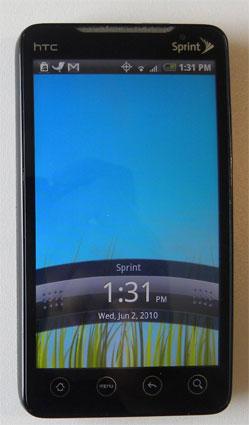
Evo 4G comes packed in what's been widely referred to as a "TV Dinner Tray" of a box. Kudos to Sprint and HTC for wide use of recycled materials throughout the packaging, but I do wonder at their odd design choices when it comes to the actual shape and look of the box. No matter, though, it's what's inside the carton that really counts. This is a big phone. It's a sleek, slim, and relatively lightweight phone considering how large of a screen it sports, but it's still a big phone and not particularly well suited to users with particularly small, dainty paws.
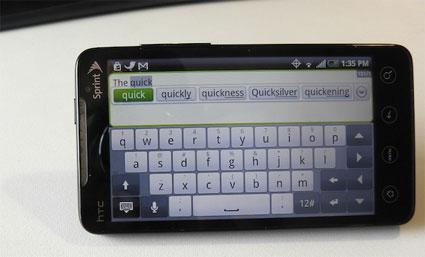
Measuring 122 x 66 x 12.7 mm, Evo 4G is roughly 15 percent wider than Droid Incredible, about 5 percent longer than both Incredible and iPhone 3GS. Perhaps more importantly, the device weighs in at 170 grams, which is a good 30 percent more than Incredible (130 g) and close to that much heavier than iPhone (135 g). Evo 4G doesn't feel imbalanced or unreasonably large and heavy for what it is, but the average consumer may balk at the phone's footprint and heft when its compared side-by-side with smaller, lighter devices.

That said, Evo is a powerful, sexy looking piece of technology, with its massive 4.3" display, glossy black finish, and form follows function minimalist aesthetic. To wit, on the front of the phone four touch controls marked by silver circles frame the bottom of Evo's display, and they're balanced by logos and a silver speaker grill above the screen. That's it, save for a multicolored notification LED hidden in the speaker grille. Simple, sleek, and functional. I like it.

The rest of Evo's industrial design speaks to its many multimedia features: Bottom-mounted ports provide microUSB connectivity for charging and data sync and microHDMI connectivity for HD video output. A top-mounted 3.5mm jack routes audio out to headphones or external speakers, and the power switch also controls screen lock to help preserve battery by dimming the giant TFT LCD panel when the phone's not in use. The left spine of Evo is bare and the right features a rocker switch for volume control. There's no trackball or D-pad to be found, as designers felt a device with 4.3" of touchscreen really didn't need a secondary means of navigation. Flip Evo over and you'll find a back panel camera sensor flanked by twin LED flash lights and a speaker grille; the camera captures eight megapixel still images and 720p HD video. There's also a flip-out kickstand that props the phone up in landscape orientation for use as a media player. That kickstand is done up in matte silver and small cutouts in the smooth grey plastic of the back panel reveal bits of bright, metallic red peeking through from the interior of the phone. Nothing like a little silver and red to spice up a slab of black and grey, right?
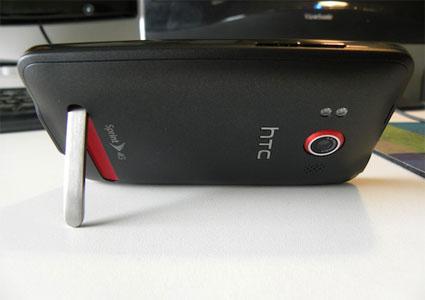
Evo pretty much flies when you use it. Powered by a 1GHz Qualcomm Snapdragon processor with 512MB of RAM and a full 1GB of ROM, and running Android 2.1 with HTC Sense, Evo 4G is one of the smoothest, most responsive smartphones currently on the market. You'd expect that from a Snapdragon device, and you get it, but the effect is arguably more impressive on Evo than on the similarly-powered Nexus One and Incredible thanks to that giant screen. The 4.3", WVGA (800 x 480) capacitive touch display supports multitouch and performed wonderfully whether I was swiping through home screens, pinching and zooming around Web pages and photos, or watching video clips (the new YouTube HQ app is great). Actually, I was perhaps most impressed with Evo's screen when playing back HD videos I'd captured using the phone - while the display doesn't support the full 1280 x 720 resolution of those HD videos, it feels like HTC and Sprint worked to optimize Evo's camcorder and display to work in concert with one another. I don't think I've ever seen a mobile device capture and play video footage with quite the spectacular results achieved by Evo 4G. When viewed clips from Evo on my computer or uploaded them to YouTube, they looked good (quite good for a cameraphone), but not as stunning as they did on Evo's own screen. Still photos, on the other hand, were pretty average for a cameraphone (if larger, at 8 MP). The camera is nice and quick, but the results were never all that stunning.

Another word on that screen: If you don't mind what 4.3" of display does to the overall size of your phone, 4.3" of display is utterly awesome. Evo doesn't actually pack more pixels into its glass than other WVGA devices, but the extra physical space is just really, really nice. Nice to look at, nice to swipe around on, and extra nice to finger/thumb-tap on. The screen is bright, and HTC and Sprint were wise to employ an "old school" TFT panel here instead of an AMOLED screen. TFT does better in bright sunlight - as such, Evo proved usable where Droid Incredible faltered in the Oakland sunshine.
Both Android and HTC's Sense UI add-on worked very well on Evo 4G. Evo's spacious display made two-thumbed typing via HTC's virtual QWERTY board quite nice in both portrait and landscape modes. Evo's version of Sense is basically the same as the ones found on Incredible, Desire, Legend, and other HTC devices running Android 2.1, and it works really well here - no lags, no prominent bugs or glitches, and it's easy enough to remove or otherwise customize the default widget set. The phone's accelerometer and proximity sensors were well-behaved and prompt, as well. While I've read and heard other reviewers complaints about battery life on Evo (and Incredible, for that matter), I didn't have any problems getting through a full day of use on a single charge, which has come to be my lowest common denominator standard for high-end smartphones.
Maybe it's because I don't load my Android devices up with an insane number of widgets or run eight apps at the same time all day long, but I really didn't have any problems with the 1500 mAh battery running low. Bear in mind that I was testing in a 3G-only area; all reports so far indicate that heavy 4G data use will suck that battery dry and right quick.
Speaking of 4G, I used Evo in San Francisco, CA and the surrounding areas across the bay to the East. Sprint's 4G WiMax service isn't available here, so I couldn't put Evo 4G's namesake feature to the test, but from what I experienced first hand at CTIA in April and what Aaron tells me from Charlotte, NC (where Sprint 4G is active), 4G is faster than EVDO Rev. A but not mind-alteringly fast - at least not yet. Heavy use of 4G data is also proving to be a big battery drain. Sprint is tacking a mandatory $10 per month "Premium Data" surcharge onto Evo owners' bills, which I think is a somewhat dubious move considering the current lack of WiMax coverage across much of Sprint's network. I get that 4G should be lit up across the land well before Evo owners' two year contracts are up, but the extra charge just doesn't feel right some how. Evo 4G also features a Mobile Hotspot app that turns the phone into a WiFi router capable of connecting up to eight devices to Sprint's data network (3G or 4G) simultaneously. Use of the Hotspot service will run you an extra $30 monthly, which is on par with other carriers' smartphone tethering plans, Verizon's Pre Plus and Pixi Plus excepted.
Data performance over EVDO and WiFi was quite good, as were voice calls placed on Evo. This version of Android doesn't support voice dialing over Bluetooth, but Bluetooth pairing to a stereo headset otherwise worked as it should. Voice commands including dialing and search worked very well when spoken directly into the phone. Google's stock voice search on supported Android phones continues to impress and amaze me - it honestly keeps getting better. I was able to command Evo to search various queries online and direct me to places around the Bay Area using Google Navigation. GPS worked well even in some semi-dodgy reception areas in the Oakland Hills. All in all, I was very happy with Evo's performance when it came to all things calling, voice command and Google Apps related, including Nav.
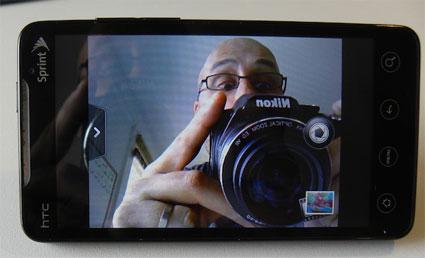
Oh yeah, I almost forgot: Evo 4G also packs a front-facing, 1.3 MP camera. The camera will be great for video chatting once the Sprint-endorsed video chat app is available. But it's still not available, so I can't say much about the front camera. I did use it for some livestreaming over Qik. The camera seemed to work just fine, but the video stream was noticeably laggy and out of sync, even for a livestream.
Modern smartphones have become so packed to the gills with features that it's impossible to cover them all while still keeping a review to a reasonable length. As such, there's a lot about Android 2.1 and HTC Sense that I've neglected here, from Facebook and Twitter integration to the super cool Google Night Sky app. Beyond that, Sprint threw in some extras like Sprint TV, which is arguably the best implementation of that service to date. Suffice it to say that it all runs well on Evo 4G, and most of it runs really well. Rest assured that Android 2.2 will be coming to Evo, though it may take a few months given that HTC first has to update Sense to play nicely with Froyo.
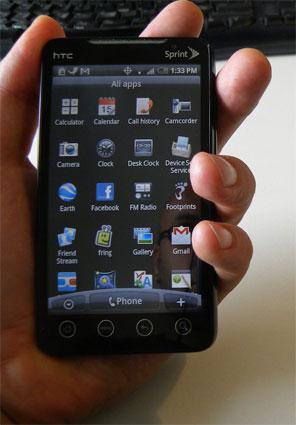
HTC and Sprint have unleashed one of the most impressive smartphones to date on the US market in the Evo 4G. Despite my annoyance with Sprint's new $10/month "Evo surcharge," $80/month for unlimited voice and data is still a great deal relative to what other national carriers are charging. Adding $30/month for Mobile Hotspot makes the deal quite a bit less sweet to me, but maybe I'll change my tune when WiMax finally comes to my neck of the woods, depending on how it actually performs.
In the end, though, Evo 4G's appeal to individual consumers will come down to three factors: The device, the software, and the carrier. Assuming, for the moment, that you're interested in an Android device and don't mind Sprint as your carrier, would I recommend Evo 4G to you? Absolutely, once you've done one thing for me. Go to a store and get an Evo in your hands. Use it one-handed, use it two-handed, hold it up to your ear, put it in your pocket or purse and walk around with it for a minute. If none of those exercises make you stop and say, "I dunno, this thing's kinda big," then go for it. Evo 4G is as impressive an Android phone as there is on the market right now, and it's got the biggest, baddest display you'll find on any of 'em, too.